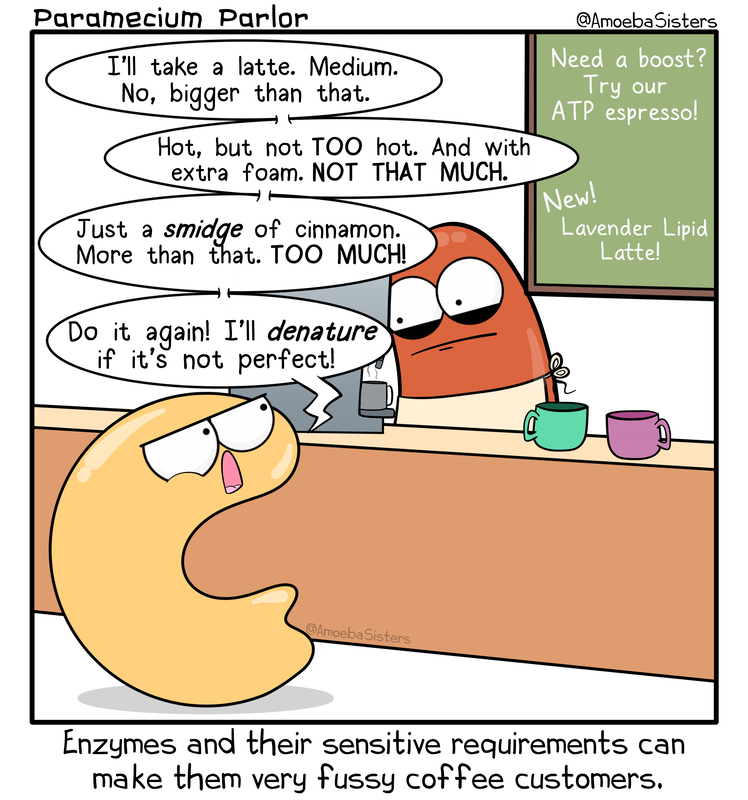Study Guide: Proteins and Enzymes
To-Do Date: Jan 23 at 12:00pmCartoon:

In the cartoon, an enzyme is being difficult and picky. By the end of this week, can you explain why enzymes are the perfect molecule to use as a barrista's nightmare customer?
Learning Objectives
By the end of this week you should be able to
- Explain the structure and function of enzymes. Specifically understand
- how they affect chemical reactions and substrates, the role of the active site, the specificity of enzymes, how the amino acid sequence determine the folding, shape and shape of the active site, importance of the reusability of enzymes, the impact of temperature, pH and substrate concentration on enzymes.
- Incorporate the function of cofactors, coenzymes and inhibitors into your understanding of enzyme reactions
Study Guide Questions:Metacognition
Some of these questions will be used for your the short answer portion of your exam. The others will be converted into multiple choice questions.
1. From this list of molecules, identify which ones are organic molecules: sugars, NaCl, O2, H2O, amino acids, lipids.
2. Without looking at your notes, fill in this chart: when you are done, double check your work and make corrections
| Type of macromolecule | Subunit | Polar or nonpolar | Example? |
3. Define the core concept: Structure and Function. Then explain the how the structure of a chemical bond determines whether a molecule is polar or not.
Structure and Function and Enzymes:
1. Explain how the amino acid sequence of an enzyme determines the shape of the active site (structure). Why are enzymes so specific? Make sure to use the following vocabulary: amino acid side chain, amino acid interactions, protein folding, shape of active site and shape of substrate(s).
2. Why do all living organisms need enzymes to catalyze reactions? Make sure to use the following vocabulary: chemical reactions, rate of reactions.
3. What would happen to an enzyme reaction if there were low concentrations of the substrate? Make sure to use the following vocabulary: collision, active site, substrate, reaction rate.
4. What would happen to an enzyme if there were low concentrations of its cofactor? Make sure to use the following vocabulary: substrates, enzyme active site, cofactor binding, shift in amino acid interactions, shift in shape of active site.
5. If there are series of enzyme reactions as seen below, what happens if there are large concentrations of the final product which is an inhibitor of the first enzyme? Make sure to use the following vocabulary: substrate, product, enzyme pathway, inhibitor, shift in in amino acid interactions, shift in shape of active site.
Substrate A ----Enzyme 1-------> Product B -----Enzyme 2-------> Product C------Enzyme 3---------> Product D